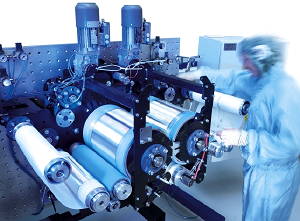Novel material can act as sensor, actuator or generator
Danfoss has set up a new subsidiary to develop and commercialise a novel material that can act as a sensor, actuator or an energy generator, depending on how it is used. The material – called Danfoss PolyPower DEAP (dielectric electro-active polymer) – consists essentially of a 70-micron-thick elastic silicone rubber film with a corrugated surface, coated on both sides with thin layers of metal that act as electrodes. The corrugations make the material stiff in one direction, but allow it to expand by up to 30% in the orthogonal direction.
When a voltage of 1–2.5kV is applied across the electrodes, they are attracted together electrostatically and the material will elongate in one direction by up to 5%, providing the basis for a linear actuator. The material, which draws power only during activation, can move up to 100 times its own weight, and achieve actuating forces of 5–20N per cm2 of material. The demonstration rig (below) shows several sheets of the film being used to lift a 10kg weight.

Although the voltages applied are high, the energy levels are low, and Danfoss says they do not pose any dangers.
If an external force is used to deform the material, the capacitance between the electrodes will vary in proportion the force, allowing the film to be used as a sensor that responds to force, pressure or strain. The material can act both as a sensor and an actuator at the same time.
Applying a force to the material can also alter the amount of energy stored in the capacitor, and this effect can be harnessed to convert mechanical energy into electrical energy to generate small amounts of power.
The origins of the material date back to 1995 when Danfoss’ president and CEO, Jørgen Mads Clausen, came up with the idea for a polymer fibre structure that would work like a human muscle. Many years of r&d have resulted in the material which is now in pilot production on a new production line in Denmark (below), which can manufacture several kilometres of it a week. Although there are rival materials being developed by companies in Switzerland and the US, Danfoss claims it is the first to achieve volume production.

“We have found a unique design that we can produce in large quantities and the material is ready to be applied in various applications,” says Michael Hannan, general manager at Danfoss PolyPower. The material made its public debut at a couple of trade shows earlier this year, including the Hannover Fair.
The material is lightweight, flexible, fast-acting and silent in operation. It has been tested to more than ten million operating cycles. In practical applications, several sheets will typically be used in parallel or rolled together to achieve useful effects.
Danfoss has already thought of a variety of potential applications for the PolyPower DEAP material including:
• proportional valves that combine the roles of actuator and position sensor;
• direct-acting dosing pumps with variable frequencies and strokes;
• active dampers to reduce vibration or noise;
• smart robotic grippers that that can adapt the force and stroke that they apply to the material they are handling;
• robotic arms with proportional, human-like movements;
• wind and wave power generators;
• ventilation controls;
• movement and force sensors incorporated into textiles and clothing;
• joysticks that combine force feedback and position sensing; and
• loudspeakers and microphones that can be formed into any shape.
Danfoss is involved in a 3½-year collaborative project, funded by the Danish Advanced Technology Foundation, to develop compact, low-cost DC-DC converters based on piezoelectric transformers combined with PolyPower actuators. This could result in alternatives to pneumatic actuators and grippers for materials-handling.
To encourage other applications for the new material, Danfoss has launched an innovation contest offering a €10,000 prize for a working prototype of a device using the film.
According to Hannan, Danfoss has invested “two-digit million Danish krone” in developing PolyPower (with 1 krone being worth around US19¢). He says that the next stage will be to turn the material into useful products and that Danfoss is looking for partners to help in this phase of the development. If all goes well, Hannan expects to see commercial products based on the technology on sale within three years.





